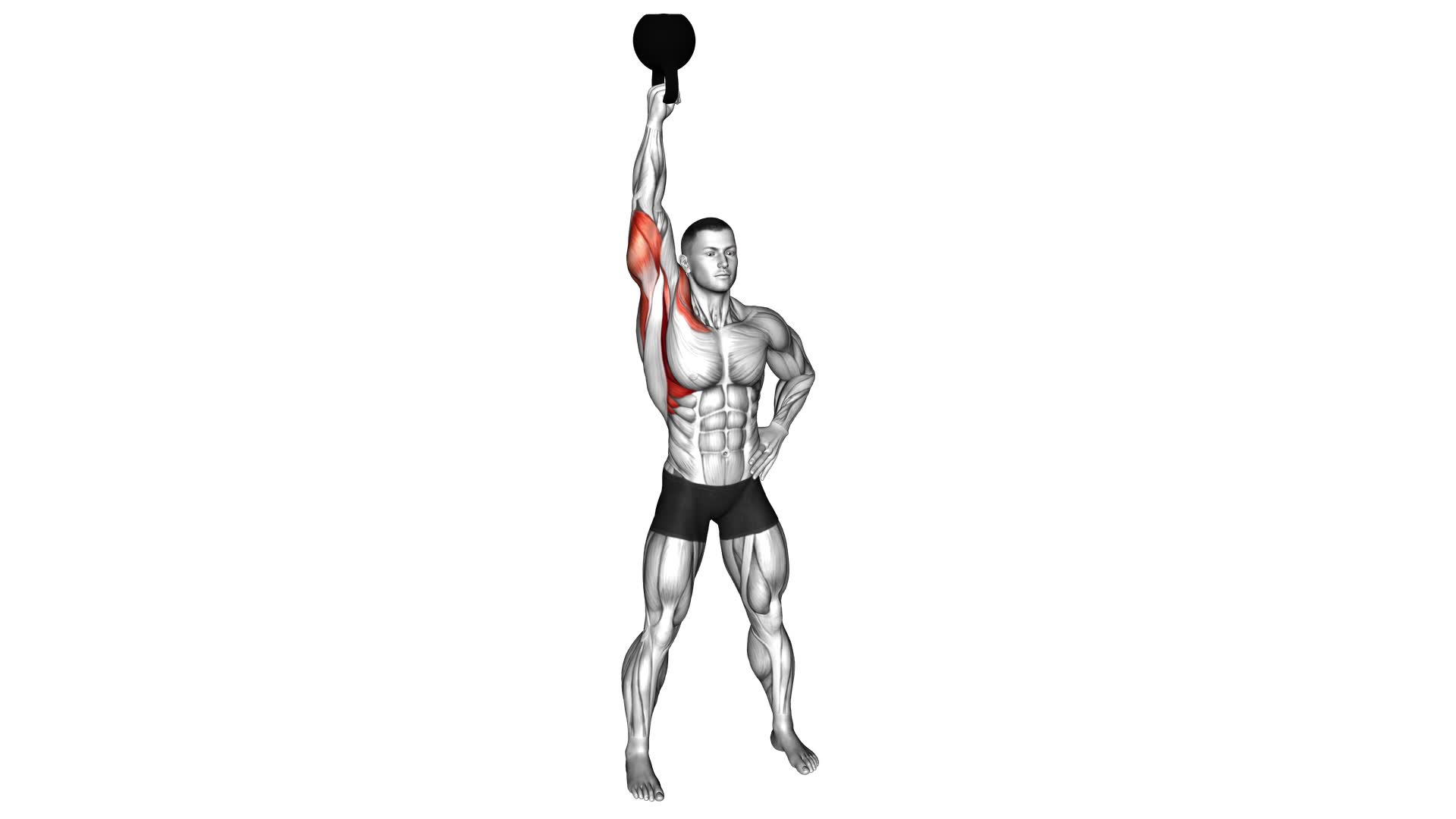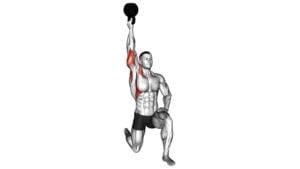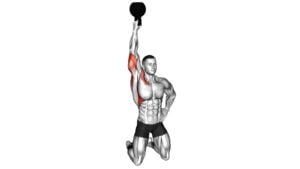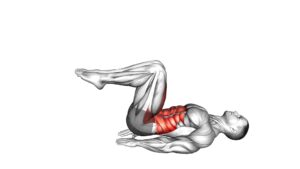Kettlebell Standing Bottoms-up One Arm Shoulder Press – Video Exercise Guide & Tips

In this video exercise guide, you'll learn all about the kettlebell standing bottoms-up one arm shoulder press.
Watch This Exercise Video
This challenging exercise offers a range of benefits for your shoulders and overall strength.
We'll show you the proper form and technique to maximize your results.
Plus, we'll cover common mistakes to avoid and provide tips for progressing and increasing difficulty.
With our expert guidance and safety precautions, you'll be able to safely and effectively incorporate this exercise into your fitness routine.
Key Takeaways
- The Kettlebell Standing Bottoms-up Shoulder Press targets deltoids, trapezius, and triceps, helping to build upper body strength.
- This exercise improves posture and increases shoulder stability, enhancing overall strength.
- Proper form and technique include gripping the kettlebell handle firmly, maintaining a straight back, and fully extending the arm during the press.
- To progress and increase difficulty, gradually increase the weight of the kettlebell, focus on proper form, and incorporate tempo variations.
Benefits of the Kettlebell Standing Bottoms-up Shoulder Press
Experience the numerous benefits of the Kettlebell Standing Bottoms-up Shoulder Press as you build strength and stability in your shoulders. This exercise specifically targets the deltoids, trapezius, and triceps, making it an effective way to develop upper body strength and improve posture.
During the kettlebell standing bottoms-up shoulder press, the deltoids are the primary muscles engaged. They're responsible for the movement of lifting the kettlebell overhead. Additionally, the trapezius muscles are activated to stabilize the shoulder joint and maintain proper alignment. The triceps also play a role in extending the elbow during the pressing motion.
To incorporate this exercise into your shoulder workout routine, start by selecting an appropriate weight kettlebell. Hold the kettlebell upside-down with the handle resting on the base of your palm. Stand with your feet shoulder-width apart and your core engaged. From there, press the kettlebell overhead, fully extending your arm, and then lower it back down to the starting position. Repeat for the desired number of repetitions.
Including the kettlebell standing bottoms-up shoulder press in your shoulder workout routine can help you develop strength, stability, and improved mobility in your shoulders. Remember to start with lighter weights and gradually increase the load as you become more comfortable and confident with the exercise.
Proper Form and Technique for the Exercise
To perform the Kettlebell Standing Bottoms-up One Arm Shoulder Press correctly, ensure that you maintain proper form and technique throughout the exercise. This exercise is great for improving stability and building shoulder strength.
Start by gripping the kettlebell handle firmly with your palm facing inward. Stand with your feet shoulder-width apart and your knees slightly bent. Keep your core engaged and your back straight throughout the movement.
Raise the kettlebell to shoulder height, keeping your elbow tucked in close to your body. Press the kettlebell upward, extending your arm fully. As you press, be sure to keep your wrist straight and stable.
Lower the kettlebell back down to shoulder height with control, and then repeat the movement for the desired number of repetitions.
It's important to note that during the exercise, you should focus on maintaining control of the kettlebell and avoiding any swinging or excessive movement. This will help prevent injury and ensure that you're targeting the shoulder muscles effectively.
Remember to breathe evenly throughout the exercise and to listen to your body. If you experience any pain or discomfort, stop the exercise and consult a fitness professional.
With proper form and technique, the Kettlebell Standing Bottoms-up One Arm Shoulder Press can be a highly effective exercise for improving stability and building shoulder strength.
Common Mistakes to Avoid
To avoid common mistakes, make sure you maintain control of the kettlebell and avoid any swinging or excessive movement. Common errors in technique can lead to shoulder injuries, so it's important to be mindful of your form during the kettlebell standing bottoms-up one arm shoulder press.
One common mistake is using too heavy of a kettlebell. This can cause you to lose control and compromise your shoulder stability. To avoid this, start with a lighter weight and gradually increase as you build strength and proficiency.
Another mistake to avoid is arching your back or leaning too far back during the press. This puts unnecessary strain on your lower back and can lead to injuries. Instead, keep your core engaged and maintain a neutral spine throughout the exercise.
Lastly, rushing through the movement is another common mistake. Take your time and focus on proper form and control. This won't only help prevent shoulder injuries but also ensure that you're effectively targeting the muscles in your shoulders and upper body.
Tips for Progressing and Increasing Difficulty
To progress and increase the difficulty of the kettlebell standing bottoms-up one arm shoulder press, you can gradually increase the weight of the kettlebell. Start with a weight that challenges you but allows you to maintain proper form and control. As you become stronger and more comfortable with the exercise, you can gradually increase the weight of the kettlebell. This will help to further develop your shoulder muscles and increase the overall difficulty of the exercise.
Another tip for progressing and increasing difficulty is to focus on your technique. Ensure that you're performing the exercise with proper form and alignment. This won't only help to prevent injuries but also maximize the effectiveness of the exercise.
Additionally, you can increase the difficulty by incorporating tempo variations. Slow down the lowering phase of the press to increase time under tension, or add a pause at the bottom of the movement before pressing the kettlebell back up. These variations will challenge your muscles in different ways and promote further progression.
Remember to listen to your body and progress at a pace that's suitable for you. Push yourself, but don't sacrifice form or safety. By gradually increasing the weight, focusing on technique, and incorporating tempo variations, you can continue to challenge yourself and make progress with the kettlebell standing bottoms-up one arm shoulder press.
Now, let's move on to the next section, where we'll discuss important safety precautions and modifications for this exercise.
Safety Precautions and Modifications
For your safety and to make modifications, it's important to be aware of certain precautions when performing the kettlebell standing bottoms-up one arm shoulder press. This exercise can be challenging and potentially risky if not done correctly.
Here are some safety precautions to keep in mind:
- Start with a lighter kettlebell: Begin with a lighter weight to ensure proper form and technique. As you become more comfortable and confident, you can gradually increase the weight.
- Maintain proper posture: Keep your back straight and engage your core throughout the exercise. This will help prevent strain on your lower back.
- Use a stable surface: Perform the exercise on a flat and stable surface to avoid any potential falls or accidents.
- Warm up before starting: Prior to performing the kettlebell shoulder press, warm up your shoulders and upper body with some dynamic stretches and mobility exercises.
In terms of modifications, there are a few options. If you don't have access to a kettlebell, you can use a dumbbell or a resistance band as an alternative. Additionally, if you have any shoulder or neck injuries, it's best to consult with a healthcare professional or a certified trainer before attempting this exercise.
Frequently Asked Questions
How Many Repetitions and Sets Should I Do for the Kettlebell Standing Bottoms-Up Shoulder Press?
For the kettlebell standing bottoms-up shoulder press, it's recommended to do 3 sets of 8 to 12 repetitions. This will help you build strength and stability in your shoulders.
Kettlebell training is great for shoulders because it engages multiple muscle groups and improves coordination. It also helps to prevent imbalances and injuries.
Can I Use Dumbbells Instead of Kettlebells for This Exercise?
Yes, you can definitely use dumbbells instead of kettlebells for this exercise.
Using dumbbells for kettlebell exercises can provide you with a great variation of the bottoms up shoulder press.
It allows you to work on your shoulder strength and stability in a slightly different way.
Just make sure to maintain proper form and start with a lighter weight until you feel comfortable with the movement.
What Muscles Does the Kettlebell Standing Bottoms-Up Shoulder Press Target?
The kettlebell standing bottoms-up shoulder press is a great exercise for targeting multiple muscles in your upper body. By using a kettlebell, you can work your shoulders, triceps, and core all at once. This exercise also helps improve stability and balance.
When performing this exercise, it's important to avoid common mistakes like using too much weight or not maintaining proper form. By being mindful of these things, you can maximize the benefits and avoid potential injuries.
How Often Should I Incorporate the Kettlebell Standing Bottoms-Up Shoulder Press Into My Workout Routine?
To progress in the kettlebell standing bottoms-up shoulder press, it's important to gradually increase the weight and reps. Start with a lighter kettlebell and focus on mastering your technique. As you become more comfortable, gradually increase the weight while maintaining proper form.
Incorporating this exercise into your workout routine has many benefits. It strengthens your shoulders, core, and stabilizer muscles, improves shoulder mobility, and enhances overall upper body strength.
Are There Any Variations of the Kettlebell Standing Bottoms-Up Shoulder Press That I Can Try?
There are several variations of the kettlebell standing bottoms-up shoulder press that you can try. These include using different weights, changing the tempo of the movement, or incorporating other exercises like lunges or squats.
These variations can help target different muscles and provide a new challenge for your workout routine.
The benefits of the kettlebell standing bottoms-up shoulder press include improved shoulder stability, increased upper body strength, and enhanced core engagement.
Conclusion
In conclusion, the kettlebell standing bottoms-up one arm shoulder press is an effective exercise for strengthening the shoulders and improving stability. By maintaining proper form and avoiding common mistakes, you can maximize the benefits of this exercise.
Progressing and increasing difficulty can be achieved by gradually increasing the weight of the kettlebell or by performing more repetitions. Remember to prioritize safety and make any necessary modifications to suit your fitness level.

Author
Years ago, the spark of my life’s passion ignited in my mind the moment I stepped into the local gym for the first time. The inaugural bead of perspiration, the initial endeavor, the very first surge of endorphins, and a sense of pride that washed over me post-workout marked the beginning of my deep-seated interest in strength sports, fitness, and sports nutrition. This very curiosity blossomed rapidly into a profound fascination, propelling me to earn a Master’s degree in Physical Education from the Academy of Physical Education in Krakow, followed by a Sports Manager diploma from the Jagiellonian University. My journey of growth led me to gain more specialized qualifications, such as being a certified personal trainer with a focus on sports dietetics, a lifeguard, and an instructor for wellness and corrective gymnastics. Theoretical knowledge paired seamlessly with practical experience, reinforcing my belief that the transformation of individuals under my guidance was also a reflection of my personal growth. This belief holds true even today. Each day, I strive to push the boundaries and explore new realms. These realms gently elevate me to greater heights. The unique combination of passion for my field and the continuous quest for growth fuels my drive to break new ground.



